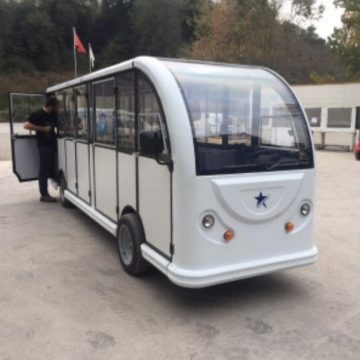SHUTTLE
It is designed and produced by an expert team specialized in the field of electric vehicles and automotive. These vehicles, produced with new generation technology, do not harm the nature thanks to their electric walking motors. The number of companies taking an environmentally friendly stance is increasing day by day. In direct proportion to this situation, passenger transport vehicles powered by internal combustion engines are being replaced by electric buses. “Why are electric buses better?” Brief answer to the question; They should be more economical in the long term, environmentally friendly, and electricity prices should generally be cheaper and more stable than fuel oils shuttle It is designed and produced by an expert team specialized in the field of electric vehicles and automotive. These vehicles, produced with new generation technology, do not harm the nature thanks to their electric walking motors. The number of companies taking an environmentally friendly stance is increasing day by day. In direct proportion to this situation, passenger transport vehicles powered by internal combustion engines are being replaced by electric buses. “Why are electric buses better?” Brief answer to the question; They should be more economical in the long term, environmentally friendly, and electricity prices should generally be cheaper and more stable than fuel oils.
Electric shuttle vehicles; It attracts great interest and demand from airports, universities, hotels, large factories and public housing. This type of electric transportation vehicles especially; It is used as a shuttle to transport passengers at airport terminals or to transport students between campuses at universities. Electric passenger transport vehicles can climb up to a certain slope. For this reason, gasoline shuttles are preferred instead of electric for roads with steep slopes. Electric shuttle service vehicles are used for short distances and at low speeds. Elektrikli yolcu taşıma araçları belirli bir eğim oranına kadar yokuş çıkabilmektedir. Bu sebeple dik yokuşların bulunduğu yollar için elektrikli yerine benzinli shuttle tercih edilmektedir. Elektrikli shuttle servis araçları kısa mesafelerde ve düşük hızlarda kullanılmaktadır.
Shuttle vehicles are suitable for use in all seasons thanks to their collapsible and openable bodies. They are generally produced with a carrying capacity of 12, 14 and 16 passengers. However, it can also be produced in smaller or larger capacities depending on demand and project. In addition to the standard features, we also provide a solution partnership that will meet your demands by producing products in line with the features you want.
A Brief History of Electric Vehicles
Electric vehicles have been around since the 19th century. In the early 19th century, researchers in Hungary, the Netherlands, and the United States began exploring the idea of battery-powered vehicles. Previously, progress had been made with a car powered by an electric motor. However, horse carriages and internal combustion engine vehicles have slowed the development of electric vehicles as people want to get around more easily and quickly.
In 1835, American Thomas Davenport began work to build the first practical electric vehicle, a small locomotive. He developed a battery-powered electric motor to run a small model car on a short track. The first successful electric car was made in the United States in 1890. William Morrison of Des Moines, Iowa, has built an electric vehicle that can seat six passengers and reach speeds of 6 to 12 miles per hour.
This initial invention helped spark interest in electric cars, and automakers around the world began creating their own versions. Due to this extraordinary sudden interest, electric cars reached very high popularity by 1900 and constituted the majority of vehicles on the road.
At that time, electric cars were the preferred vehicles. However, around the same time, improvements were made to the gasoline-powered car, which caused the electric car to lose some momentum. Gasoline vehicles have over time surpassed the popularity of electric-powered vehicles.
By 1935, electric cars almost disappeared. In the 1970s, electric cars returned to the market. Gasoline cars remained popular due to better performance and reliability, but electric vehicles were making a comeback in the market.
In the 1990s, electric vehicles became more popular as public concerns about environmentalism began to increase. At the beginning of the 21st century, the technology of electric cars developed much more. As people become more conscious, environmentally friendly vehicles are becoming very popular. Therefore, the demand for electric vehicles is increasing day by day in this century.




